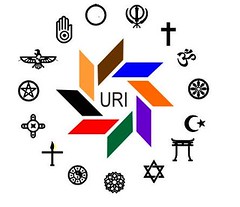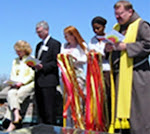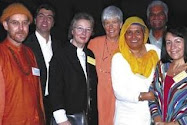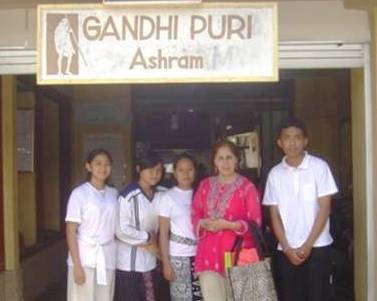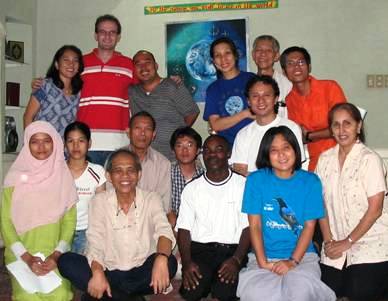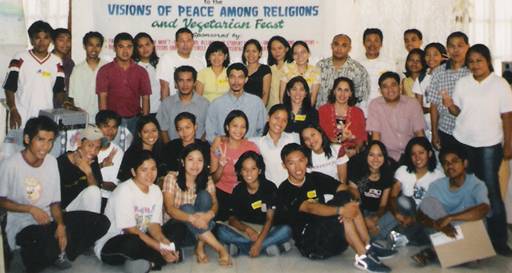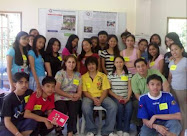 By Swami Guhabhaktananda*
By Swami Guhabhaktananda*Hindu wisdom, which inspires humans to live the ideals of compassion and nonviolence, is captured in one word, ahimsa. Very simply, ahimsa is abstaining from causing harm or injury. It is gentleness and non-injury, whether physical, mental or emotional, it goes much deeper to prohibit even subtle abuse and simple hurt.
Non-violence has long been central to the religious traditions of India. Religion in India has consistently upheld the sanctity of life whether human, animal or elemental. There developed early in India an unparalleled concern for harmony among different life forms, and this led to a common ethos based on non-injuriousness and a minimal consumption of natural resources, in other words to compassion and simplicity.
One of the most ancient Hindu scriptures, the Bhagavad Gita, is often mistaken as Divine sanction for violence. The Mahabrata (of which the Gita is a part) itself says,”Ahimsa is the highest dharma. It is the highest purification. It is also the highest truth from which all dharma proceeds.” What is Dharma? Hinduism describes dharma as the natural universal laws whose observance enables humans to be content and happy, and to save himself from degradation and suffering. Dharma is the moral law combined with spiritual discipline that guides one’s life.
Swami Sivananda Saraswati Maharaj says, “To be free from violence is the duty of every man. No thought of revenge, hatred or ill will should arise in our minds. Injuring others gives rise to hatred.”
From the Hindu perspective, to cultivate and achieve peace among religions is to first understand the role of religion. Religion is the relationship between the three fundamental principles – God, World and the Individual. Religion is not a denial of life but it is fullness of life. It consists of doing well to others, in the practical love, mercy, truthfulness and purity in all walks of life. We believe the fundamentals or essentials of all religions are the same. They are as old as the human race. There never has been, there never shall be, any real invention of discovery in the sphere of religion. Real religion is ONE. It is the religion of service, sacrifice and renunciation of wrong notion. It is the religion of goodness, kindness and tolerance.
The message of Hinduism to the modern world is the fundamental oneness of humanity; the spiritual unity of mankind through divine fellowship; universal love and brotherhood of man; the immanence of God; and religious tolerance; which makes for the universality of Hinduism. Truth and Love is neither Hindu nor Islamic, nor Buddhist nor Christian! Truth is ONE, homogenous, eternal substance. This is the UNIVERSAL RELIGION.
Every religion has an outer form or shell, and an inner essence or core. The outer shell consists of rites, rituals, ceremonies, beliefs, myths and doctrines. These vary from one religion to another. But there is an inner core common to all religions: the universal teachings of morality and charity, of a disciplined and pure mind full of love, compassion, good will and tolerance.
It is this common denominator that religious leaders ought to emphasize, and that religious adherents ought to practice. If proper importance is given to the essence of all religions and greater tolerance is shown for their superficial aspects, conflict can be eradicated.
An extraction from Atharva Veda:
“I ordain for you concord of heart, unanimity of and freedom from hatred in dealings with each other. Love one another in all ways.”
“Let your bodies and mind work together in harmony for the achievement of the common ideal (general welfare). It is for this that God the Protector of the Universe, has brought you together in life.”
Hinduism is neither asceticism nor illusionism, neither polytheism nor pantheism. It is a synthesis of all types of religious experiences. It is whole and complete view of life, characterized by wide toleration, deep humanity and free from fanaticism. Living a dharmic life adjusting to externals and non-essentials is the key in fostering peace among religions.
Many preach religion, but no one gives up desires and Himsa. Many preach, but no one practices love and forgiveness. Many preach, but no one recognizes the brotherhood of man. Many preach, but no one realizes the Divinity in all. Preaching has become the livelihood of men, while practice has become their object of scorn. Teach by being and learn by doing. Be Good and Do Good is the essence of all religions.
What is needed is proper understanding of the fundamental teachings of all religions and apply it in one’s daily life. Therefore, let everyone practice his/her own religion and realize among fellow human beings the real purpose of all religions.
Hari Om Tat Sat!
*Swami Guhabhaktananda is the President of Divine Life Society in Malaysia. He presented this article during the Peace Among Religions interfaith conference organized by InSaF URI KLCC on March 18, 2007 held at the Singghasana Hotel in Petaling Jaya, Malaysia.
